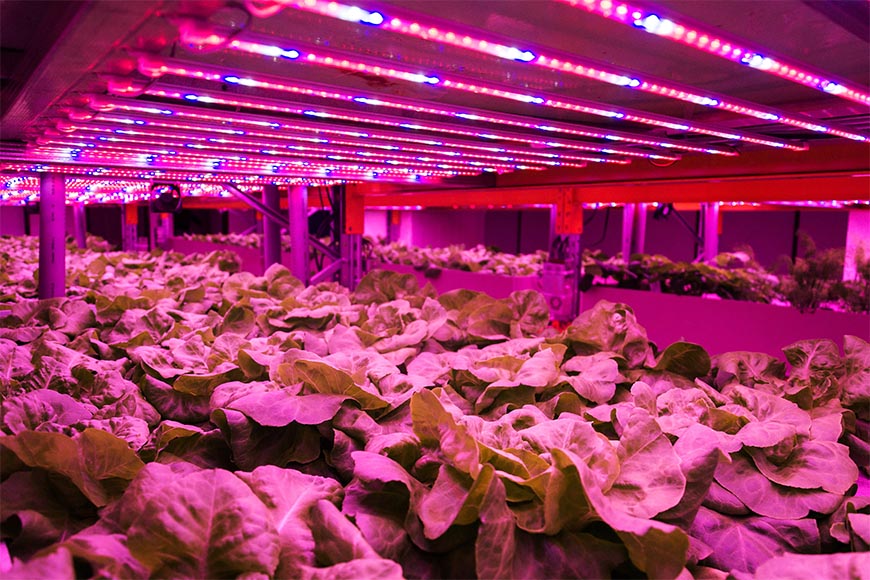
Lettuce is a fast-growing green that can be grown year-round indoors and out.
It will grow best in the garden with cooler growing conditions, leaving a crisper and fresher taste. Rows can be spaced very close together, about 2’’ apart for loose-leaf lettuce, or plants can be given more space to grow out into full heads. It’s often recommended to start the season off with a few full heads. Once temperatures warm up in the summer, grow loose-leaf lettuce in a partial sun location.
To grow a winter crop for those in colder northern states, start full-size head seeds in late summer and early fall. Starting the lettuce in late fall gives it enough time to obtain 70% of its full growth before light hours shorten too much for ideal growth. Utilizing cold frames, grow tunnels, or other sheltered locations can also extend the growing season for lettuce into the winter.
There are a lot of different ways to grow lettuce indoors, from simple hydroponics with just a mason jar and a grow light, to racks with lights and growing medium. Either way, you go about growing indoors you are going to need to invest in some type of grow light. Lettuces respond really well to LED lights, which have low electric costs compared to using stronger high-intensity discharge lights.
As for outdoor growing, the first seeds or transplants can be planted in early spring once the soil is warm enough to work. There are a few different ways to start lettuce seeds in the early spring. one option is to plant them straight into the garden beds, this works well if they get enough protection and proper watering to germinate. another option is to order lettuce starts or pick up store-bought starts.
To assist the lettuce in the garden you can make homemade cold frames or simply use cut open milk jugs. Another option would be to place the seeds under a cloth covering with a small hoop structure. If these options are not available, start the seeds indoors under a grow light or in a greenhouse.
If using tray or pots to plant the seeds, fill them with a seed starting mix that’s clean and free of other seeds and molds. Make a ½ inch hole in each space and drop a seed or two in each spot. Cover with more seed starting mix and water lightly. Place in a warm well-lit area and allow time to germinate. Make sure the plants get enough light to avoid etiolation (the act of the stem lengthening and reaching for light), as this will make the transplants weak.
The process for sowing lettuce seeds outdoors in late spring to mid-summer is very similar to the process for indoors or undercover. The only exception is the outdoor soil must be tended before planting to remove weeds and create a rich soil that holds moisture well. Place a seed every few inches in rows that are 8’’ or more apart, depending on the varieties. Keep an eye on young seedlings as slugs can quickly damage a young plant.
Once indoor-raised seedlings are large enough to handle, gradually harden them off by placing them outside during the day and inside at night for at least a week. Soil preparation for transplanting is about the same as for the seedlings. Turn over the dirt lightly and mix in some quality compost and nutrients. Plant the seedlings in the prepared soil at least 8’’ apart.
If the outside temperature unexpectedly drops, protect the plants with a cover cloth, blanket, or plastic cover to keep the leaves from freezing.
It is important to keep the lettuce well weeded so that light and nutrients are more accessible to them. Additionally, it is important to keep the plants moist, especially in hot weather. Drying out could cause the lettuce to flower too quickly, which could lead to bitter-tasting lettuce. The addition of compost tea from early on to a few weeks just before harvest can help reduce pests as well as improve flavor and crispness.
Slugs and snails are a common pest during the summer months that can turn our lettuce slimly and gross. Setting traps and using compost tea can help suppress the pests. Other critters can become problematic so it is important to keep an eye out for all garden pests.
It can also be beneficial to cover the lettuce with an insect barrier that allows ample light through but hinders the pests from getting in. There are many pest management techniques and it is important to find one that fits well with your gardening style and beliefs (e.g. companion planting, pesticides, manually picking bugs, sticky traps, and more).
As the loose leaf matures and fills in the rows, cut the leaves as needed for the plant health and your kitchen needs. Use straight from the garden or wash and refrigerate for later use. Leaves will last a few days in the fridge but make sure to keep them in a cloth bag. If you are growing any varieties for the full head, allow the plant to mature to full size and use a sharp knife to cut the head at the soil’s surface. Starting the lettuce crop undercover in early spring, tending it through the summer, and continuing into late fall can help maintain a year-long harvest of these wonderful crops.
